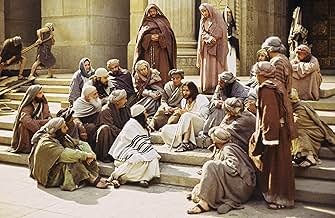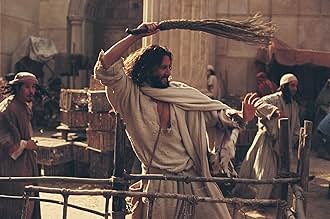ÉVALUATION IMDb
7,8/10
4,3 k
MA NOTE
Ajouter une intrigue dans votre langueThe story of Jesus' life as told by the apostle John, narrated by Christopher Plummer.The story of Jesus' life as told by the apostle John, narrated by Christopher Plummer.The story of Jesus' life as told by the apostle John, narrated by Christopher Plummer.
- Prix
- 1 victoire et 3 nominations au total
Christopher Plummer
- Narrator
- (voice)
Paul Alexander Nolan
- Bridegroom
- (as Paul Nolan)
Heinar Piller
- High Official #3
- (as Heinar Pillar)
Histoire
Le saviez-vous
- AnecdotesThe dialog follows the Good News Bible, word for word, in sequential order from beginning to end.
- GaffesAfter Jesus performs his first miracle of turning the water into wine at the wedding feast, he pours the wine into what appears to be a plastic cup (to help us see the color of what was water). Actually, colorless glass has been around since approximately the 9th century BC.
- Citations
Jesus Christ: A person who has had a bath needs only to wash his feet; his whole body is clean, and you are all clean, all except one.
- ConnexionsFollows The Visual Bible: Matthew (1993)
- Bandes originalesSymphony No.5
Music by Valentin Silvestrov
Performed by The Ural Philharmonic Orchestra
Conducted by Andrey Boreyko
Produced by Megadisc
Commentaire en vedette
Perfect for an agnostic, Phillip Seville's three-hour transcription of John the apostle's life of Christ eschews the common cliches of glorification found in the Synoptic Gospels of Matthew, Mark, and Luke; makes Christ human; and presents some convincing evidence for His deity at the same time. `The Gospel of John' does not do a Hollywood makeover of anyone in this film in order to prove that Christ was the Son of God (Mary is older and more wrinkled than she should be), therefore satisfying those undecideds who sometimes claim Him an ordinary man and other times suspect He may be divine.
For sure, He is not the charismatic figure of `The Greatest Story Ever Told' or `King of Kings,' but Saville makes the miracles pervasive enough to coax anyone, even an atheist or Jew, to pause and ponder the possibility.
Because so many are awaiting Mel Gibson's controversial life of Christ with its alleged hard line about the responsibility of the Jews for Christ's death, Saville's version may be interesting by comparison. Because both films show Jews responsible for Christ's death, there should be no wasted time debating responsibility when discussing the difference in the films. The ruling Romans, Pilate in particular, share the decision to crucify Him as well (The film's preamble asserts that crucifixion was a Roman practice).
The adaptation by John Goldsmith from the American Bible Society's `Good News Bible' is faithful to that 1996 colloquial Bible. The actors' Shakespearean delivery echoes many of the previous filmed versions that substitute gravitas for good acting. But a skeptic has to be enchanted by the simple message and the selfishness of the Pharisees and Romans, even though they are unwittingly fulfilling `God's purpose.'
Played by Henry Ian Cusick, Christ has no extraordinary physical features and no exceptional oratorical skill beyond his few poignant homilies and epigrammatic philosophy. Don't look for the grand pronouncements of the Sermon on the Mount; in fact, his repetitious `I speak the truth' has the opposite effect of creating disbelief in listeners wary when anyone has to declaim this more than once.
Yet, His presence changes things: The agnostic or the Jew must take note of the `teacher's' humanity--he also happens to raise people from the dead and change water into wine. It's in those miracles, emphasized by the film, that the mystery of Christ as the Son of God demands the attention of even the most unmovable agnostic or atheist.
Christopher Plummer's narration, intoned with a bit too much respect, gets laughable as he describes all too obvious actions when they are happening at the same time on the screen (`Christ stood up.'). This is not Pasolini's witty, sensual `Gospel According to St. Matthew.' It is a faithful rendering of the fourth gospel in understandable idioms with a feisty Christ different from the usual pacifist with backlighting.
After all, we do base our calendar on the year of the Lord, so somewhere we must come to terms with the arguably most influential religious figure in history. `The Gospel of John' is a place to start.
For sure, He is not the charismatic figure of `The Greatest Story Ever Told' or `King of Kings,' but Saville makes the miracles pervasive enough to coax anyone, even an atheist or Jew, to pause and ponder the possibility.
Because so many are awaiting Mel Gibson's controversial life of Christ with its alleged hard line about the responsibility of the Jews for Christ's death, Saville's version may be interesting by comparison. Because both films show Jews responsible for Christ's death, there should be no wasted time debating responsibility when discussing the difference in the films. The ruling Romans, Pilate in particular, share the decision to crucify Him as well (The film's preamble asserts that crucifixion was a Roman practice).
The adaptation by John Goldsmith from the American Bible Society's `Good News Bible' is faithful to that 1996 colloquial Bible. The actors' Shakespearean delivery echoes many of the previous filmed versions that substitute gravitas for good acting. But a skeptic has to be enchanted by the simple message and the selfishness of the Pharisees and Romans, even though they are unwittingly fulfilling `God's purpose.'
Played by Henry Ian Cusick, Christ has no extraordinary physical features and no exceptional oratorical skill beyond his few poignant homilies and epigrammatic philosophy. Don't look for the grand pronouncements of the Sermon on the Mount; in fact, his repetitious `I speak the truth' has the opposite effect of creating disbelief in listeners wary when anyone has to declaim this more than once.
Yet, His presence changes things: The agnostic or the Jew must take note of the `teacher's' humanity--he also happens to raise people from the dead and change water into wine. It's in those miracles, emphasized by the film, that the mystery of Christ as the Son of God demands the attention of even the most unmovable agnostic or atheist.
Christopher Plummer's narration, intoned with a bit too much respect, gets laughable as he describes all too obvious actions when they are happening at the same time on the screen (`Christ stood up.'). This is not Pasolini's witty, sensual `Gospel According to St. Matthew.' It is a faithful rendering of the fourth gospel in understandable idioms with a feisty Christ different from the usual pacifist with backlighting.
After all, we do base our calendar on the year of the Lord, so somewhere we must come to terms with the arguably most influential religious figure in history. `The Gospel of John' is a place to start.
- JohnDeSando
- 20 janv. 2004
- Lien permanent
Meilleurs choix
Connectez-vous pour évaluer et surveiller les recommandations personnalisées
- How long is The Gospel of John?Propulsé par Alexa
Détails
- Date de sortie
- Pays d’origine
- Langue
- Aussi connu sous le nom de
- The Gospel of John
- Lieux de tournage
- Tabernas, Almería, Andalucía, Espagne(Cave scene)
- sociétés de production
- Consultez plus de crédits d'entreprise sur IMDbPro
Box-office
- Budget
- 10 000 000 $ US (estimation)
- Brut – États-Unis et Canada
- 4 069 090 $ US
- Fin de semaine d'ouverture – États-Unis et Canada
- 98 363 $ US
- 28 sept. 2003
- Brut – à l'échelle mondiale
- 4 078 741 $ US
- Durée3 heures
- Couleur
- Mixage
- Rapport de forme
- 1.85 : 1
Contribuer à cette page
Suggérer une modification ou ajouter du contenu manquant

Lacune principale
What is the Spanish language plot outline for The Visual Bible: The Gospel of John (2003)?
Répondre


































